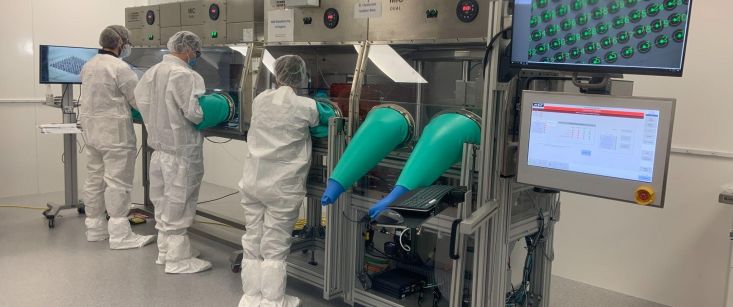As an HBS student in Professor Vicki Sato’s Commercializing Science class, I wanted to tackle an unmet global health care need by applying my engineering and business skills to a solvable problem. Working with my cofounders, we saw an opportunity to supply much-needed vaccines worldwide without refrigeration or cold storage using silk. During our first year as a bootstrapped startup, Vaxess won the inaugural Harvard President’s Innovation Challenge, as well as several other business competitions. A decade later, Vaxess has adapted and innovated our business model. COVID-19 showed us that to be prepared for the next global pandemic, we need to make a fundamental paradigm shift in the method of vaccine delivery in two major ways, administration of and access to vaccines. Vaxess has moved to a platform vaccine delivery company, owning a new method and instrument of delivery.
Vaxess Technologies, along with teams at Tufts University and The Massachusetts Institute of Technology, have developed the MIMIX platform. This technology changes vaccine delivery from a needle-and-syringe to a patch-based format, similar to a nicotine patch. Patients apply the patch as simply as an ordinary Band-Aid. No sharp needles, no wasted vials of vaccine, no crying children afraid to get a shot! MIMIX enables home-based vaccination for the first time.
In the MIMIX patch, this simplified administration is combined with a breakthrough biomaterial, fibroin that stabilizes vaccines, reducing or eliminating the need for cold-chain storage and distribution. Vaccines are now shippable and relatively shelf stable. Amazon and the USPS can deliver vaccines directly to patients. They can be purchased at retail or mail-order pharmacies. The difficulty of access for the general population of all age groups is greatly reduced. There is no delayed rollout, healthy people are not forced to congregate at mass vaccination sites or wait weeks for an appointment.
Vaxess’ long-term strategy not only relies on investing in the technology of vaccine delivery, but also in manufacturing. We saw how many businesses were slowed and nearly grounded as supply chains were interrupted. To that end, Vaxess went vertical and invested in manufacturing. The challenge is that MIMIX manufacturing is uniquely complex. No other company produces patch-based vaccines, so the process is completely new. Patch production combines elements of roll-based manufacturing (think Band-Aids) with a unique fill-finish process involving computer-vision guided printing. With support from ATS Automation, Vaxess developed a custom production line that ensures consistent, high-quality patches without contamination. It could move more quickly and better ensure the quality of its products if it owned the entire process.
In less than ten months, Vaxess and Cummings Properties turned an empty warehouse in Woburn, Massachusetts into a cGMP (Current Good Manufacturing Practices) manufacturing suite and a GLP (Good Laboratory Practices) laboratory. In parallel, the company established its own quality system to support products from this new facility. In March of 2022, Vaxess produced the first human clinical batches for the company’s lead program, a seasonal influenza vaccine called MIMIX-Flu, which entered clinical trials for the first time in the summer of 2022.
While the Woburn site is an important step, it is only designed to support Phase I and Phase II clinical trials. In parallel, the company has begun looking to the next phase of manufacturing, scaling up to the hundreds of millions of patches necessary to make an impact in the next pandemic. For comparison sake, the existing COVID vaccine manufacturers have combined to produce more than one billion total doses. The challenge of the vaccine space is that massive volumes are needed to protect the seven billion patients around the world. Without the scale to protect the global population, viruses like COVID will continue to mutate and impact all of our lives.
Much of Vaxess’s work to date has been funded by Government agencies, with the National Institutes of Health, the National Science Foundation, BARDA, DARPA, and NASA all contributing. The company has supplemented this with venture capital financing. Vaxess is working closely with all of these funders to achieve the scale necessary to reimagine both the traditional seasonal influenza market while also preparing for the next pandemic. As COVID taught us, the more we prepare now, the quicker we can get back to normal when the next pandemic hits.
As I look back at Vaxess years, it has been fantastic to see life sciences grow at HBS and within the Boston biotech community. I enjoy being a Key Advisory Board member for the Blavatnik Fellowship in Life Science Entrepreneurship and utilizing my experience to help the next generation of life science leaders making a difference in the world.
About the author: Michael Schrader (MBA 2012) is the CEO of Vaxess, a clinical-stage company bringing health care out of the clinic and into patients’ lives with the MIMIX Smart Release patch platform. The company has a pipeline of vaccines and biologics under development, including the first influenza vaccine intended for home-based administration. The company has raised more than $60M in grant and VC funding from groups such as The MIT Engine, BARDA, DARPA, NIH, NSF, and The Gates Foundation. He serves as an Expert in Residence at the Harvard Office of Technology Development and as a Key Advisory Board Member for the HBS Blavatnik Fellowship program. Michael received his B.S. in Mechanical Engineering from Purdue University and his M.B.A. from Harvard University.







